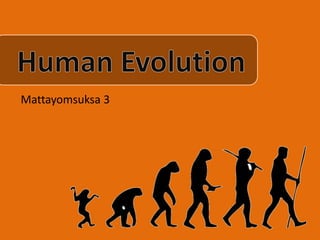
Human evaluation
- 2. Human characteristics of chimps - BBC wildlife
- 10. Structure Comparative Adjectives Comparative adjectives are used when describing the differences between ONLY two items. S + V to be + adj er + than S + V to be + more + adj + than For example H. habilis had a brain that was larger than the largest Autralopithecus brain, but smaller than the Homo erectus brain.
- 11. For example Neanderthal's brain was larger than the brain of living humans, although its shape was longer from front to back and not as rounded in the front. The brain was enclosed in a skull that was more rounded than H. erectus'.
- 13. Ardipithecus ramidus The most primitive hominid yet found, this species has more chimpanzee-like features than any other human ancestor. Ardipithecus ramidus may have walked upright. Other fossils discovered with a ramidus suggest that the species lived in the forest. 4.4 million years ago first fossils found 1992
- 14. Australopithecus anamensis Exhibiting some chimp-like characteristics, A. anamensis' jaws are more primitive than those of later hominids. And yet, its humerus (an arm bone) is quite human-like. Characteristics of its tibia (a lower leg bone) indicate that A. anamensis walked on two feet. 4.2 - 3.9 million years ago first fossils found 1965
- 15. Australopithecus afarensis This species includes "Lucy," the 3.2 million year old fossil found by Donald Johanson. A. afarensis' small braincases and relatively large teeth and chewing muscles are similar to those of chimpanzees. However, their teeth, as well as their leg and pelvis bones, exhibit human-like characteristics. They ranged in height from three and a half feet to five feet and walked upright. 3.5 - 2.9 million years ago first fossils found 1973
- 16. Australopithecus africanus Although similar in many ways to A. afarensis, this species had a slightly larger brain (but still only slightly larger than a chimp's brain), smaller canine teeth, and larger molars. The wear of the teeth suggests that A. africanus ate fruits and foliage. 3.0 - 2.4 million years ago first fossils found 1924
- 17. Australopithecus robustus Believed to be roughly the same size as A. afarensis, A. robustus had a large, "robust" (heavier, thicker) skull, as well as a jaw and large teeth that were well adapted to chewing. Like some present-day apes, this species had a "sagittal crest" (a ridge running from front to back on the top of the skull) from which muscles running to the jaw were attached. 2.1 - 1.6 million years ago first fossils found 1938
- 18. Australopithecus boisei A. boisei is similar to A. robustus, except that its skull and teeth are even larger. Some experts consider the two closely related, both branching from another species called A. aethiopicus. Others believe A. robustus evolved from A. africanus. Like all of the other Autralopithecus species, A. boisei walked upright. 2.3 - 1.1 million years ago first fossils found 1959
- 19. Homo habilis Homo habilis, which actually means "handy man," is apparently the first species to make and use primitive stone tools. About five feet tall and weighing 100 pounds, H. habilis had a brain that was larger than the largest Autralopithecus brain, but smaller than the Homo erectus brain. 2.4 - 1.5 million years ago first fossils found 1960
- 20. Homo erectus The first example of Homo erectus, known as "Java Man," was discovered in Indonesia in 1893. Fossil remains of Homo erectus have since been found throughout Africa and Asia, making it the first wide-ranging hominid. Despite the primitive appearance of its skull, the erectus skeleton is very similar to that of modern humans, although more robust (thicker and heavier). Homo erectus was probably the first hominid to use fire. 1.8 million years ago - 300,000 years ago first fossils found 1893
- 21. Homo sapiens (archaic) Also known as Homo heidelbergensis, this species has a brain that was larger than H. erectus' and smaller than that of a modern human. The brain was enclosed in a skull that was more rounded than H. erectus'. Fossil remains of archaic Homo sapiens have been found in Africa and Europe. 500,000 - 200,000 years ago first fossil found in 1921
- 22. Homo sapiens neanderthalensis Averaging five and a half feet in height and possessing short limbs, Neanderthals were well-adapted to living in a cold climate. Attached to their robust (thick and heavy) bones were powerful muscles. The Neanderthal's brain was larger than the brain of living humans, although its shape was longer from front to back and not as rounded in the front. 230,000 - 30,000 years ago first fossil found in 1856
- 23. Homo sapiens (modern) Modern Homo sapiens, also known as Homo sapiens sapiens, have been around for the past 120,000 years. Homo sapiens living about 40,000 years ago made elaborate tools out of bone, antler, ivory, stone, and wood, and produced fine artwork in the form of carvings and cave paintings. 120,000 years ago - present first "Cro-Magnon" specimens found in 1868
- 25. Role-play -make a group of 4 -send 1 representative of your group to pick up a piece of color paper -act to describe the all feathers about the name of age that you have got -come in front of the class to perform
